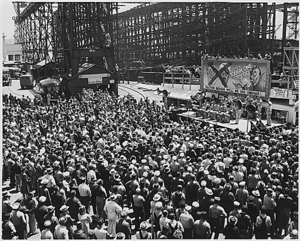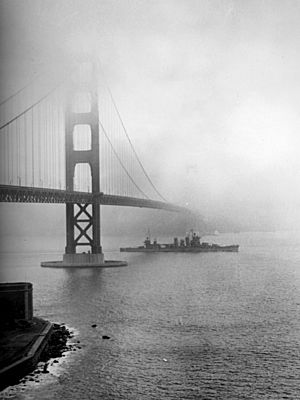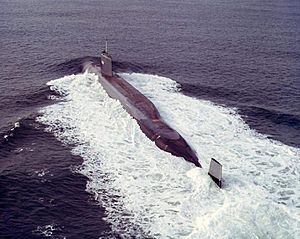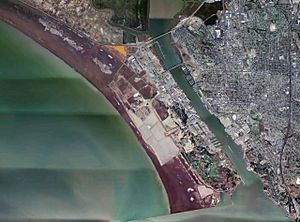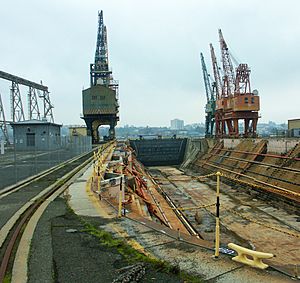Mare Island Naval Shipyard facts for kids
|
Mare Island Naval Shipyard
|
|
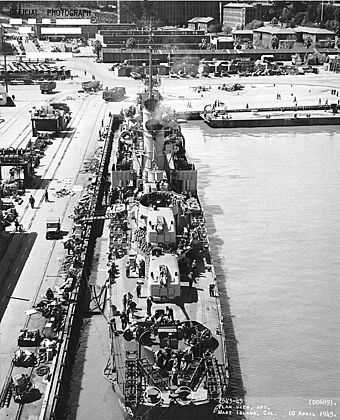
USS Wadleigh at Mare Island Naval Yard, 10 April 1945.
|
|
| Location | Vallejo, California |
|---|---|
| Built | 1854 |
| NRHP reference No. | 75002103 |
Quick facts for kids Significant dates |
|
| Added to NRHP | 15 May 1975 |
| Designated NHLD | 15 May 1975 |
The Mare Island Naval Shipyard (MINSY) was the very first United States Navy base built on the Pacific Ocean. It is located about 25 miles northeast of San Francisco in Vallejo, California. The Napa River flows through the Mare Island Strait, separating the shipyard on Mare Island from the main part of Vallejo. MINSY became famous as the top submarine port on the US West Coast. It also played a huge role in building ships in the San Francisco Bay Area during World War II.
The base closed in 1996 and has been redeveloped for new uses. It was recognized as a special historical place in California in 1960. Parts of it were also named a National Historic Landmark District in 1975.
Contents
How it Started
In September 1849, Lieutenant Commander William Pope McArthur was in charge of a US survey ship called Ewing. This ship had sailed all the way around Cape Horn to the West Coast. When they reached San Francisco, Ewing and another ship, USS Massachusetts, had trouble. Many of their crew members left to join the gold rush. Some even tried to escape by throwing an officer overboard!
Despite these problems, they managed to survey the Mare Island Strait. Then they sailed to Hawaii to find new crew members from King Kamehameha III. They came back to San Francisco in the spring of 1850. They started surveying the coast of northern California on April 4, 1850. This survey continued all the way up to the Columbia River. On August 1, 1850, while in Oregon, McArthur bought a small part of Mare Island for $468.50. He then returned to San Francisco to make maps and write reports.
On January 15, 1852, the Secretary of the Navy, Will A. Graham, ordered a group of Navy officers to choose a spot for a naval yard on the Pacific Coast. Commodore D. Sloat and other officers were part of this group. On July 13, 1852, Sloat suggested the island across the Napa River from Vallejo.
The Navy bought the first 956 acres (387 hectares) of Mare Island Naval Shipyard on January 4, 1853. McArthur's family received $5,218.20 for their share. The Navy started building ships there on September 16, 1854. The first commander was Commander David Farragut. He later became famous during the U.S. Civil War for saying, "Damn the torpedoes, full speed ahead!" Mare Island became a major repair station in the Pacific in the late 1800s. It fixed American, Japanese, and Russian ships.
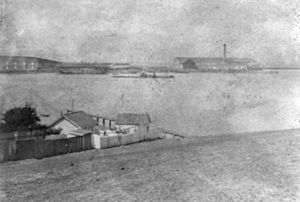
In 1861, a very long-lived clipper ship called Syren came to Mare Island Navy Yard for repairs. It needed $15,000 worth of work. Syren had hit Mile Rock twice while trying to sail out of the Golden Gate.
Marines first arrived at Mare Island in 1862. They were led by Maj Addison Garland, who was the first officer to command the Marine barracks there.
Mare Island Naval Shipyard also helped with civil defense and emergencies on the West Coast. It sent warships to the Pacific Northwest to help with Native American conflicts. MINSY also sent ships like Wyoming south to Central America and the Panama Canal. This was to protect US interests. Mare Island also provided support, supplies, and weapons for the Spanish–American War. After the 1906 earthquake, MINSY sent people, materials, and ships to San Francisco to help with the fires. It also launched Arctic rescue missions when needed. Making and storing weapons was another key job at MINSY for almost its entire history. This included weapons used before the American Civil War.
In 1911, the Marine Corps opened two recruit training centers on the West Coast. One was at Mare Island, and the other was in Puget Sound, Washington. Mare Island became the only West Coast recruit training center in 1912. This happened when the Puget Sound operation moved to the San Francisco Bay Area. Instructors trained new Marines there until August 10, 1923. Then, they moved to the Marine Corps Recruit Depot San Diego.
World War I Efforts
In March 1917, there was a big explosion at MINSY. Barges loaded with weapons blew up. Six people died, 31 were hurt, and some port buildings were destroyed. US Military Intelligence agents connected the blast to a German spy named Lothar Witzke. He was caught and put in prison in 1918.
MINSY built many ships during World War I. It still holds a record for how fast it built a destroyer. It launched USS Ward in just 17 and a half days in May–June 1918. The Navy chose Mare Island to build the only dreadnought battleship made on the US West Coast, USS California. It was launched in 1919. In 1904, the older type of battleship, USS Nebraska, had been launched in Seattle, Washington.
After seeing how powerful German U-boats were in World War I, the Navy decided to build more submarines. They started a submarine program at MINSY in the early 1920s. This doubled their Pacific-based submarine construction program, which also included Puget Sound Naval Shipyard.
World War II Contributions
During World War II, the base had a hospital, a place to store ammunition, and labs for testing paint and rubber. It also had schools for firefighters, opticians, and anti-submarine attack training. MINSY worked at its highest capacity during the war. It built, repaired, and maintained many different types of ships, including both surface ships and submarines.
Up to 50,000 workers were employed at Mare Island. The shipyard even worked on Royal Navy cruisers and destroyers. It also serviced four Soviet Navy submarines. After the war, MINSY was a main place for building and maintaining the Navy's Pacific fleet of submarines. By the end of the war, it had built seventeen submarines and four submarine support ships.
Before World War II, the Navy set up Station I at Mare Island. This was one of four High Frequency Direction Finding (HFDF) stations on the Pacific mainland. These stations tracked Japanese naval and merchant ships east of Hawaii.
Supporting the War Effort
The workers at Mare Island were very patriotic. The military and civilian workers raised almost $76 million in war bonds. This was enough money to pay for every submarine built at MINSY before VJ Day. More than 300 landing craft were also built at Mare Island.
Ships Built at Mare Island
Mare Island Naval Shipyard built at least eighty-nine ships. Here are some of the important ones:
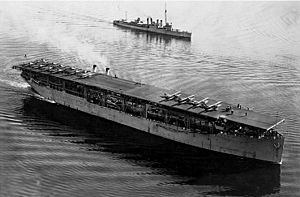
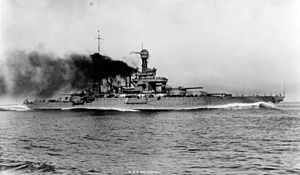
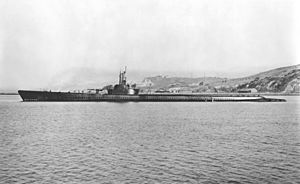
- 1858 USS Saginaw – a wooden warship
- 1872 USS Mohican – a wooden warship
- 1874 USC&GS McArthur – a Steamer
- 1875 USS Monadnock – a steel monitor
- 1886 USRC Cosmos – a wooden Revenue Cutter
- 1904 USS Intrepid – a steel training ship
- 1907 USS Prometheus – a steel collier (coal ship)
- 1911 USS Jupiter – a steel collier. Later became the aircraft carrier USS Langley.
- 1913 USS Kanawha – a steel tanker
- 1913 USRC Guard – a wooden harbor tug for the Revenue Cutter Service
- 1913 USS Palos – a steel gunboat
- 1913 USS Monocacy – a steel gunboat
- 1914 USS Maumee – a steel tanker
- 1915 USS Cuyama – a steel tanker
- 1916 USS Shaw – a steel destroyer
- 1916 USS California – a steel battleship
- 1916 USS Caldwell – a steel destroyer
- 1917 Fifteen wooden submarine chasers
- 1917 USS Fairfax – a destroyer
- 1917 USS Taylor – a destroyer
- 1918 USS Boggs – a destroyer
- 1918 USS Kilty – a destroyer
- 1919 USS Kennison – a destroyer
- 1918 USS Ward – a destroyer (was at attack on Pearl Harbor)
- 1918 USS Claxton – a destroyer
- 1919 USS Hamilton – a destroyer
- 1920 USS Montana – a battleship (never finished)
- 1920 USS Litchfield – a destroyer
- 1920 USS Zane – a destroyer (was at attack on Pearl Harbor)
- 1921 USS Wasmuth – a destroyer (was at attack on Pearl Harbor)
- 1922 USS Trever – a destroyer (was at attack on Pearl Harbor)
- 1922 USS Perry – a destroyer (was at attack on Pearl Harbor)
- 1922 USS Decatur – a destroyer
- 1927 USS Nautilus – a submarine (sank 6 ships in WWII)
- 1928 USS Chicago – a cruiser
- 1931 USS San Francisco – a cruiser (was at attack on Pearl Harbor)
- 1934 USS Smith – a destroyer
- 1934 USS Preston – a destroyer
- 1935 USS Henley – a destroyer (was at attack on Pearl Harbor)
Before and during World War II, Mare Island Naval Shipyard became very good at building submarines. After a few submarine support ships, they stopped building surface ships there. MINSY kept building non-nuclear submarines through the Cold War. This included two of the three Barracuda-class submarines and USS Grayback, an early missile submarine. In 1955, Mare Island won the contract to build Sargo. This was the first nuclear submarine built at a Pacific base.
The shipyard became one of the few places that built and repaired nuclear submarines. This included several UGM-27 Polaris submarines. In 1970, Drum was launched. This was the last nuclear submarine built in California. In 1972, the Navy officially stopped building new nuclear submarines at Mare Island. However, they continued to repair existing ones. Nautilus was taken out of service at Mare Island in 1980. Then, it was prepared to be towed back to Groton, Connecticut. It is now a museum of naval history.
- 1936 USS Pompano – submarine (sank 6 ships in WWII)
- 1936 USS Sturgeon – submarine (sank 9 ships in WWII)
- 1937 USS Swordfish – submarine (sank 12 ships in WWII)
- 1939 USS Fulton – submarine tender (support ship)
- 1939 USS Tuna – submarine (sank 4 ships in WWII)
- 1939 USS Gudgeon – submarine (sank 11 ships in WWII)
- 1941 USS Sperry – submarine tender
- 1941 USS Silversides – submarine (sank 23 ships in WWII, 3rd highest for a US submarine)
- 1941 USS Trigger – submarine (sank 18 ships in WWII, 11th highest for a US submarine)
- 1942 USS Bushnell – submarine tender
- 1942 USS Wahoo – submarine (sank 20 ships in WWII, 6th highest for a US submarine)
- 1942 USS Whale – submarine (sank 9 ships in WWII)
- 1942 USS Sunfish – submarine (sank 15 ships in WWII)
- 1942 USS Tunny – submarine (sank 7 ships in WWII)
- 1942 USS Tinosa – submarine (sank 16 ships in WWII)
- 1942 USS Tullibee – submarine (sank 3 ships in WWII)
- 1943 USS Howard W. Gilmore – submarine tender
- 1943 USS Seahorse – submarine (sank 20 ships in WWII, 6th highest for a US submarine)
- 1943 USS Skate – submarine (sank 10 ships in WWII)
- 1943 USS Tang – submarine (sank 24 ships in WWII, 2nd highest for a US submarine)
- 1943 USS Tilefish – submarine (sank 2 ships in WWII)
- 1944 USS Spadefish – submarine (sank 21 ships in WWII, 4th highest for a US submarine)
- 1944 USS Trepang – submarine (sank 11 ships in WWII)
- 1944 USS Spot – submarine (sank 1 ship in WWII)
- 1944 USS Springer – submarine (sank 4 ships in WWII)
- 1945 USS Nereus – submarine tender
- 1945 USS Stickleback – submarine
- 1947 USS Tiru – submarine
- 1951 USS Bass – submarine
- 1951 USS Bonita – submarine
- 1957 USS Grayback – submarine
- 1957 USS Sargo – nuclear powered submarine
- 1959 USS Halibut – nuclear powered submarine
- 1959 USS Theodore Roosevelt – nuclear powered submarine
- 1960 USS Scamp – nuclear powered submarine
- 1961 USS Permit – nuclear powered submarine
- 1961 USS Plunger – nuclear powered submarine
- 1962 USS Andrew Jackson – nuclear powered submarine
- 1963 USS Woodrow Wilson – nuclear powered submarine
- 1963 USS Daniel Boone – nuclear powered submarine
- 1963 USS Stonewall Jackson – nuclear powered submarine
- 1964 Trieste II – a deep-diving submarine
- 1965 USS Kamehameha – nuclear powered submarine
- 1965 USS Mariano G. Vallejo - nuclear powered submarine
- 1967 USS Gurnard – nuclear powered submarine
- 1968 USS Guitarro – nuclear powered submarine
- 1969 USS Hawkbill – nuclear powered submarine
- 1969 USS Pintado – nuclear powered submarine
- 1970 USS Drum – nuclear powered submarine
River Training
In 1966, during the Vietnam War, the U.S. Navy moved its "Brown Water Navy" Riverine Training Operations to Mare Island. This training had been in Coronado, California. People driving on Highway 37 could often see U.S. Navy River Patrol Boats. These boats and other river assault boats practiced in the sloughs (small waterways) of what is now the Napa-Sonoma State Wildlife Area. This area is next to the north and west parts of Mare Island.
U.S. Navy Reserve Units might still use these waterways for training. This is because the navigable waters are considered public property. The U.S. Navy Brown Water Riverine Forces were stopped after the Vietnam War. Only the U.S. Naval Reserve PBRs and other small boats stayed at Mare Island until the base closed in 1996.
Base Closure
Mare Island Naval Shipyard grew to over 5,200 acres (2,100 hectares) during its time in service. It built over 500 naval vessels and repaired thousands of others. Even though it was still very important, MINSY was chosen to close in 1993. This was part of a process called Base Realignment and Closure (BRAC). Naval operations stopped, and the facility was officially closed on April 1, 1996.
Today, the California Conservation Corps, Touro University California, and many other businesses are using the property at the former naval shipyard. In May 2000, the Navy finished transferring a former housing area called Roosevelt Terrace. This was done to help the local economy. The Navy is also transferring property at the shipyard to other government groups. These include the Fish and Wildlife Service for a refuge, a Forest Service office, an Army Reserve Center, a Coast Guard communications facility, and a Department of Education school.
Images for kids
See also
 In Spanish: Mare Island Naval Shipyard para niños
In Spanish: Mare Island Naval Shipyard para niños





